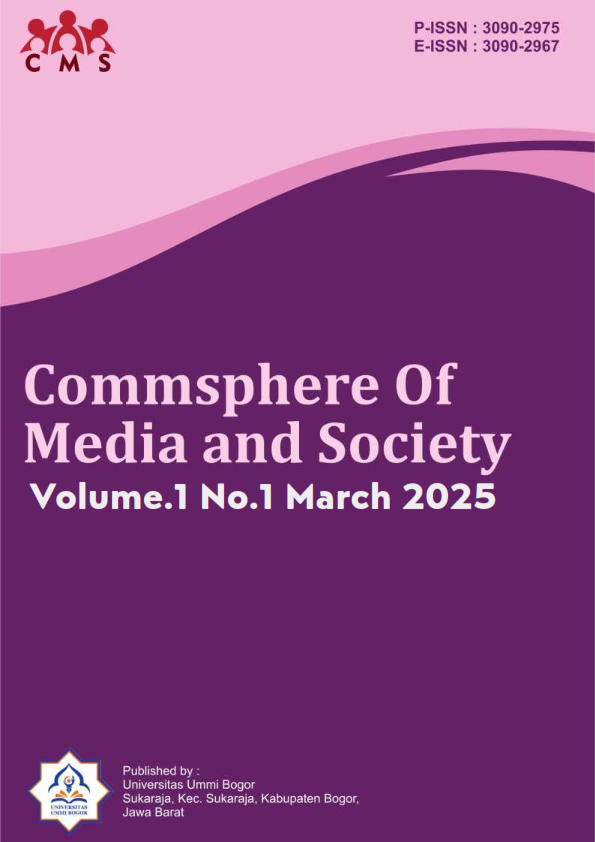Deconstruction Of Female Tattoo Artists From A Postmodern Feminist Perspective
Keywords:
sexism, stereotypes, female tattoo artists, deconstruction, post-feminismAbstract
This research analyzes women's resistance against sexism and stereotypes in the context of the tattoo artist profession in Indonesia. In a society where patriarchal culture remains strong, women often face symbolic discrimination and social stigma that hinder their freedom of expression and professional mobility. Using a qualitative approach and Jacques Derrida’s deconstruction theory, this research unpacks hidden meanings in language and discourse that shape stereotypes against women, particularly in the tattoo art industry. Deconstruction enables a rereading of gender constructions that have long reinforced male dominance in various sectors, including art and culture. Furthermore, this study draws on post-feminism and postmodernism perspectives to examine how female tattoo artists not only challenge traditional norms but also reconstruct their identities within the framework of individual freedom, agency, and gender fluidity. Post-feminism highlights how women are no longer merely objects of resistance against patriarchy but actively redefine their roles and existence in public spaces. Meanwhile, postmodernism provides an understanding that identity and social meanings are fluid and negotiable, allowing female tattoo artists to renegotiate their positions in society through artistic expression and social actions. The findings reveal that, despite facing resistance from conservative communities, female tattoo artists in Indonesia have successfully carved out their own existential space by demonstrating professional competence, artistic skills, and engagement in positive social activities. Their resistance against sexism is not only expressed through the rejection of stereotypes but also through strategies of identity reconstruction and the creation of new meanings within their profession. This study contributes to gender, art, and cultural studies by offering new perspectives on how women can deconstruct social boundaries and create space for diverse gender expressions in the contemporary era.
References
Adib, S. (2009). Aplikasi kritik sastra feminisme: Perempuan dalam karya-karya Kuntowijoyo. Yogyakarta: Citra Pustaka Yogyakarta.
Adorno. (1998). On popular music. Dalam J. Storey (Ed.), Cultural theory and popular culture: A reader (2nd ed.). England: Prentice Hall.
Amanda, G., & Ni Made Ras. (2009). Masyarakat majemuk II stereotipe, prasangka, pluralisme (Makalah, tidak diterbitkan). Dalam S. Fatimah (2014), Jurnal Musawa Pemberian Stereotipe Gender. Retrieved from https://media.neliti.com/media/publications/138333-ID-pemberian-stereotype-gender.pdf
Amstrong, dkk. (2008). Motivation for contemporary tattoo removal: A shift in identity. Arch Dermatol, 144(7). Retrieved from https://www.drjkoch.org/Research/Tattoo%20Remover%20AoD.pdf
Ardianto, E. (2011). Metodologi penelitian untuk public relations kuantitatif dan kualitatif. Bandung: Simbiosa Rekatama Media.
Arivia, G. (2004). Gelombang ketiga feminisme: Inul? Kompas, 17 Maret 2004. Dalam Prasetyo, B., & Kuncoro, (2010). Membaca diskursus postfeminisme melalui novel Perempuan di Titik Nol. Jurnal Komunitas Fakultas Ilmu Sosial, Universitas Negeri Semarang, Indonesia. Retrieved from https://journal.unnes.ac.id/nju/index.php/komunitas/article/download/2283/2335
Aw, S. (2010). Komunikasi sosial budaya. Yogyakarta: Graha Ilmu.
Bachmann-Medick, D. (2003). Culture as text. Berlin: De Gruyter.
Bagus, F. (2019). Wawancara mengenai industri tato, profesi seniman tato, seniman tato perempuan. Magic Ink Magazine. Bali, 13 Februari 2019.
Barker, C. (2004). Cultural studies: Teori & praktik (N. Nurhadi, Trans.). Yogyakarta: Kreasi Wacana.
Bernard, S. (1992). Hornbill and dragon: Arts and culture of Borneo. Singapore: ESun Tree.
Bourdieu, P. (1991). Language and symbolic power. Cambridge: Polity.
Bourdieu, P. (Distinctions: A social critique of the judgment of taste* (R. Nice, Trans.). Cambridge, MA: Harvard University.
Boyne, R. (1991). The art of the body in the discourse of postmodernity. Dalam M. Featherstone et al. (Eds.), The body: Social process and cultural theory. New Delhi: Sage Publications.
Bruner, E. M. (1986). Experience and its expressions. Dalam V. W. Turner & E. M. Bruner (Eds.), The anthropology of experience. Urbana and Chicago: University of Illinois Press.
Burton, G. (2012). Media dan budaya populer. Yogyakarta: Jalasutra.
Castells, M. (1997). The power of identity. Oxford: Blackwell.
Dayanti, L. D. (2006). Potret kekerasan gender dalam sinetron komedi di televisi. Jurnal Masyarakat, Kebudayaan dan Politik, 19(3). Retrieved from http://www.journal.unair.ac.id/filerPDF/POTRET%20KEKERASAN%20GENDER%20DALAM.pdf
Dewi, S. (2011). Wanita bertato: Faktor-faktor yang mempengaruhi dan motivasinya. Retrieved from http://portalgaruda.fti.unissula.ac.id/index.php?ref=browse&mod=viewarticle&article=123256
Fakih, M. (1999). Analisis gender & transformasi sosial. Yogyakarta: Pustaka Pelajar.
Fakih, M. (2001). Menggeser konsepsi gender dan transformasi sosial. Yogyakarta: Pustaka Pelajar.
Fakih, M. (2008). Analisis gender dan transformasi sosial. Yogyakarta: INSISTPress.
Fiske, J. (1995). Memahami budaya populer. Yogyakarta: Jalasutra.
Gamble, S. (2004). Feminisme dan postfeminisme. Yogyakarta: Jalasutra.
Graddol, D., & Swann, J. (2003). Gender voices: Telaah kritis relasi bahasa gender. Pasuruan: Pedati.
Hannam, J. (2007). Feminism. Harlow, England: Pearson-Longman.
Haryatmoko. (2010). Dominasi penuh muslihat: Akar kekerasan dan diskriminasi. Jakarta: Gramedia.
Humm, M. (2002). Ensiklopedia feminisme (M. Rahayu, Trans.). Yogyakarta: Fajar Pustaka Baru.
Ibrahim, I. S. (2005). Lifestyle ecstasy: Kebudayaan pop dalam masyarakat komoditas Indonesia (Edisi Kedua). Yogyakarta: Jalasutra.
Ida, R. (2014). Studi media dan kajian budaya. Jakarta: Prenada Media Group.
Johnson, D. W., & Johnson, F. P. (2000). Joining together: Group theory and group skill. New York: Pearson Education Company.
Kartono, K. (1992). Psikologi wanita jilid I (Mengenal gadis remaja dan wanita dewasa). Bandung: Mandar Maju.
Kellner, D. (2010). Budaya media, cultural studies, identitas, dan politik: Antara modern dan postmodern. Yogyakarta: Jalasutera.
Kriyantono, R. (2007). Teknik praktis riset komunikasi. Jakarta: Kencana.
Kuntjara, E. (2003). Gender, bahasa, dan kekuasaan. Jakarta: PT BPK Gunung Mulia dan UK Petra Surabaya.
Lerner, J. W. (1988). Learning disabilities: Theories, diagnosis, dan teaching strategies. Boston: Houghton Mifflin Company.
Lipovetsky, G. (1994). The empire of fashion. Princeton, N.J.: Princeton University Press.
Lubis, Y. A. (2014). Postmodernisme: Teori dan metode. Jakarta: Rajawali Pers.
Lubis, Y. A. (2015). Pemikiran kritis kontemporer: Dari teori kritis, cultural studies, feminisme, postkolonial hingga multikulturalisme. Jakarta: Rajawali Pers.
Moleong, L. J. (2007). Metodologi penelitian kualitatif. Bandung: PT Remaja Rosdakarya Offset.
Mulyana, D. (2012). Ilmu komunikasi: Suatu pengantar. Bandung: Rosda.
Sugiyono. (2006). Metode penelitian kuantitatif, kualitatif, dan R&D. Bandung: Alfabeta.
Tong, R. P. (2010). Feminist thought: Pengantar paling komprehensif kepada aliran utama pemikiran feminis. Yogyakarta: Jalasutra.
Webster, M. (2004). Merriam Webster’s Collegiate Dictionary. United States of America: Merriam Webster Incorporated.
Williams, R. (1983). Keywords. London: Fontana.
Downloads
Published
Issue
Section
License
Copyright (c) 2025 Journal of Communication Cakrawala

This work is licensed under a Creative Commons Attribution-ShareAlike 4.0 International License.





